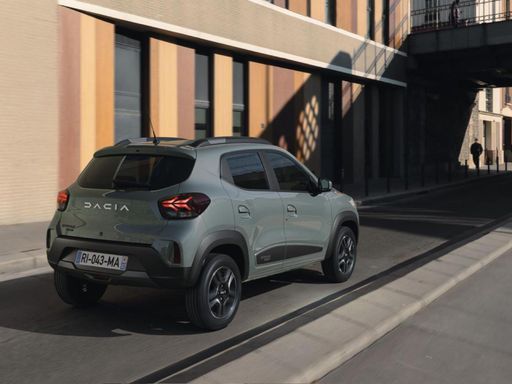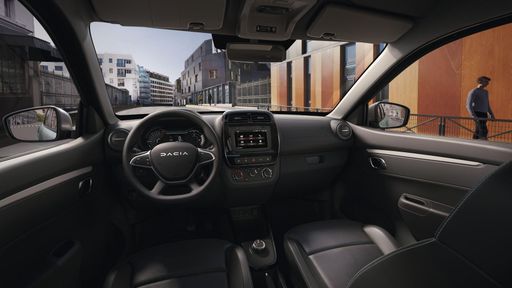Dacia Spring vs Renault R4 – Which car suits you better?
Two cars, one duel: Dacia Spring meets Renault R4.
Which one wins in performance, efficiency and value for money? Find out now!
Here’s where it gets real: The technical differences in detail
Costs and Efficiency: When it comes to price and running costs, the biggest differences usually appear. This is often where you see which car fits your budget better in the long run.
Dacia Spring has a significantly advantage in terms of price – it starts at 14500 £, while the Renault R4 costs 25200 £. That’s a price difference of around 10715 £.
In terms of energy consumption, the advantage goes to the Dacia Spring: with 13.20 kWh per 100 km, it’s barely noticeable more efficient than the Renault R4 with 14.20 kWh. That’s a difference of about 1 kWh.
As for range, the Renault R4 performs convincingly better – achieving up to 409 km, about 181 km more than the Dacia Spring.
Engine and Performance: Power, torque and acceleration say a lot about how a car feels on the road. This is where you see which model delivers more driving dynamics.
When it comes to engine power, the Renault R4 has a clearly edge – offering 150 HP compared to 65 HP. That’s roughly 85 HP more horsepower.
In acceleration from 0 to 100 km/h, the Renault R4 is clearly quicker – completing the sprint in 8.20 s, while the Dacia Spring takes 13.70 s. That’s about 5.50 s faster.
In terms of top speed, the Renault R4 performs to a small extent better – reaching 150 km/h, while the Dacia Spring tops out at 125 km/h. The difference is around 25 km/h.
There’s also a difference in torque: the Renault R4 pulls convincingly stronger with 245 Nm compared to 125 Nm. That’s about 120 Nm difference.
Space and Everyday Use: Whether family car or daily driver – which one offers more room, flexibility and comfort?
Seats: Renault R4 offers slightly more seating capacity – 5 vs 4.
In curb weight, the Dacia Spring is decisively lighter – 1013 kg compared to 1485 kg. The difference is around 472 kg.
In terms of boot space, the Renault R4 offers evident more room – 420 L compared to 308 L. That’s a difference of about 112 L.
In maximum load capacity, the Renault R4 performs clearly perceptible better – up to 1405 L, which is about 401 L more than the Dacia Spring.
When it comes to payload, Renault R4 clearly perceptible takes the win – 443 kg compared to 302 kg. That’s a difference of about 141 kg.
All in all, the Renault R4 shows itself to be wins the duel decisively and secures the title of DriveDuel Champion.
It impresses with the more balanced overall package and proves to be the more versatile companion for everyday use.
Dacia Spring
The Dacia Spring stands out as an affordable and environmentally friendly option in the electric vehicle market, combining practicality with a compact design ideal for urban settings. Its minimalist interior, while basic, provides all the essential features needed for a comfortable drive, reflecting its cost-effective approach. The vehicle's performance suits city driving, making it an appealing choice for those seeking an entry-level electric car.
details @ dacia-presse.de
@ dacia-presse.de
 @ dacia-presse.de
@ dacia-presse.de
 @ dacia-presse.de
@ dacia-presse.de
Renault R4
The Renault R4, affectionately known as the "R4," is a quintessential symbol of French automotive simplicity and practicality. This classic compact car, originally introduced in the early 1960s, won over numerous enthusiasts with its versatile design and dependable performance. Its no-frills charm and robust build made it a beloved choice for rural drivers and city dwellers alike, cementing its status as an iconic piece of automotive history.
details

|
|
|
|
|
Costs and Consumption |
|
|---|---|
|
Price
14500 - 17100 £
|
Price
25200 - 31200 £
|
|
Consumption L/100km
-
|
Consumption L/100km
-
|
|
Consumption kWh/100km
13.2 - 14.1 kWh
|
Consumption kWh/100km
14.2 - 15.1 kWh
|
|
Electric Range
225 - 228 km
|
Electric Range
308 - 409 km
|
|
Battery Capacity
26.80 kWh
|
Battery Capacity
40 - 52 kWh
|
|
co2
0 g/km
|
co2
0 g/km
|
|
Fuel tank capacity
-
|
Fuel tank capacity
-
|
Dimensions and Body |
|
|---|---|
|
Body Type
SUV
|
Body Type
SUV
|
|
Seats
4
|
Seats
5
|
|
Doors
5
|
Doors
5
|
|
Curb weight
1013 - 1050 kg
|
Curb weight
1485 - 1537 kg
|
|
Trunk capacity
308 L
|
Trunk capacity
420 L
|
|
Length
3701 mm
|
Length
4144 mm
|
|
Width
1583 mm
|
Width
1808 mm
|
|
Height
1519 mm
|
Height
1552 mm
|
|
Max trunk capacity
1004 L
|
Max trunk capacity
1405 L
|
|
Payload
265 - 302 kg
|
Payload
410 - 443 kg
|
Engine and Performance |
|
|---|---|
|
Engine Type
Electric
|
Engine Type
Electric
|
|
Transmission
Automatic
|
Transmission
Automatic
|
|
Transmission Detail
Reduction Gearbox
|
Transmission Detail
Reduction Gearbox
|
|
Drive Type
Front-Wheel Drive
|
Drive Type
Front-Wheel Drive
|
|
Power HP
44 - 65 HP
|
Power HP
122 - 150 HP
|
|
Acceleration 0-100km/h
13.7 - 19.1 s
|
Acceleration 0-100km/h
8.2 - 9.2 s
|
|
Max Speed
125 km/h
|
Max Speed
150 km/h
|
|
Torque
113 - 125 Nm
|
Torque
225 - 245 Nm
|
|
Number of Cylinders
-
|
Number of Cylinders
-
|
|
Power kW
33 - 48 kW
|
Power kW
90 - 110 kW
|
|
Engine capacity
-
|
Engine capacity
-
|
General |
|
|---|---|
|
Model Year
2024
|
Model Year
2025
|
|
CO2 Efficiency Class
A
|
CO2 Efficiency Class
A
|
|
Brand
Dacia
|
Brand
Renault
|
What drive types are available for the Dacia Spring?
The Dacia Spring is available as Front-Wheel Drive.
The prices and data displayed are estimates based on German list prices and may vary by country. This information is not legally binding.
